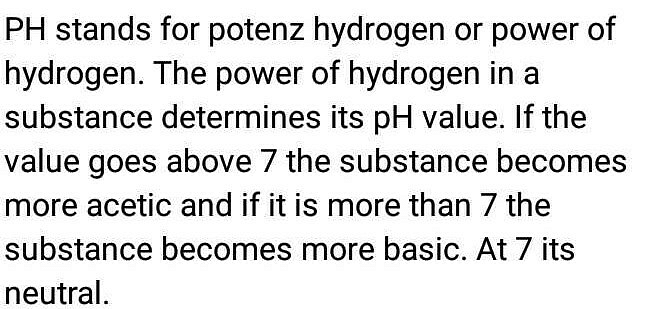Class 10 Exam > Class 10 Questions > What is ph value? Define?
Start Learning for Free
What is ph value? Define?
Most Upvoted Answer
What is ph value? Define?
What is pH value?
Definition of pH value
Importance of pH value
Measurement of pH value
Examples of pH values
The pH value is a measure of the acidity or basicity (alkalinity) of a solution. It is a numerical scale that ranges from 0 to 14, with 7 being neutral. Solutions with a pH less than 7 are considered acidic, while those with a pH greater than 7 are considered basic (alkaline).
Definition of pH value
The term pH is derived from the French word "puissance d'hydrogen," which means the power of hydrogen. The pH value is a measure of the concentration of hydrogen ions (H+) in a solution. The pH scale is logarithmic, meaning that each whole number change in pH represents a tenfold change in acidity or basicity. For example, a solution with a pH of 3 is ten times more acidic than a solution with a pH of 4.
Importance of pH value
The pH value is an important parameter in many scientific fields, including chemistry, biology, and environmental science. It is used to measure the acidity or alkalinity of a solution, which can affect many chemical and biological processes. For example, the pH of soil can affect plant growth, while the pH of blood can affect enzyme activity.
Measurement of pH value
The pH value can be measured using a pH meter or pH paper. A pH meter is a device that measures the electrical potential difference generated by a solution when it comes into contact with an electrode. pH paper is a strip of paper that has been treated with a pH-sensitive chemical that changes color in response to the acidity or basicity of a solution.
Examples of pH values
Some common examples of pH values include:
- Lemon juice - pH 2
- Vinegar - pH 3
- Coffee - pH 5
- Water - pH 7
- Blood - pH 7.4
- Milk of magnesia - pH 10
- Ammonia - pH 11
- Bleach - pH 12
Attention Class 10 Students!
To make sure you are not studying endlessly, EduRev has designed Class 10 study material, with Structured Courses, Videos, & Test Series. Plus get personalized analysis, doubt solving and improvement plans to achieve a great score in Class 10.

|
Explore Courses for Class 10 exam
|

|
What is ph value? Define?
Question Description
What is ph value? Define? for Class 10 2024 is part of Class 10 preparation. The Question and answers have been prepared according to the Class 10 exam syllabus. Information about What is ph value? Define? covers all topics & solutions for Class 10 2024 Exam. Find important definitions, questions, meanings, examples, exercises and tests below for What is ph value? Define?.
What is ph value? Define? for Class 10 2024 is part of Class 10 preparation. The Question and answers have been prepared according to the Class 10 exam syllabus. Information about What is ph value? Define? covers all topics & solutions for Class 10 2024 Exam. Find important definitions, questions, meanings, examples, exercises and tests below for What is ph value? Define?.
Solutions for What is ph value? Define? in English & in Hindi are available as part of our courses for Class 10.
Download more important topics, notes, lectures and mock test series for Class 10 Exam by signing up for free.
Here you can find the meaning of What is ph value? Define? defined & explained in the simplest way possible. Besides giving the explanation of
What is ph value? Define?, a detailed solution for What is ph value? Define? has been provided alongside types of What is ph value? Define? theory, EduRev gives you an
ample number of questions to practice What is ph value? Define? tests, examples and also practice Class 10 tests.

|
Explore Courses for Class 10 exam
|

|
Suggested Free Tests
Signup for Free!
Signup to see your scores go up within 7 days! Learn & Practice with 1000+ FREE Notes, Videos & Tests.


























